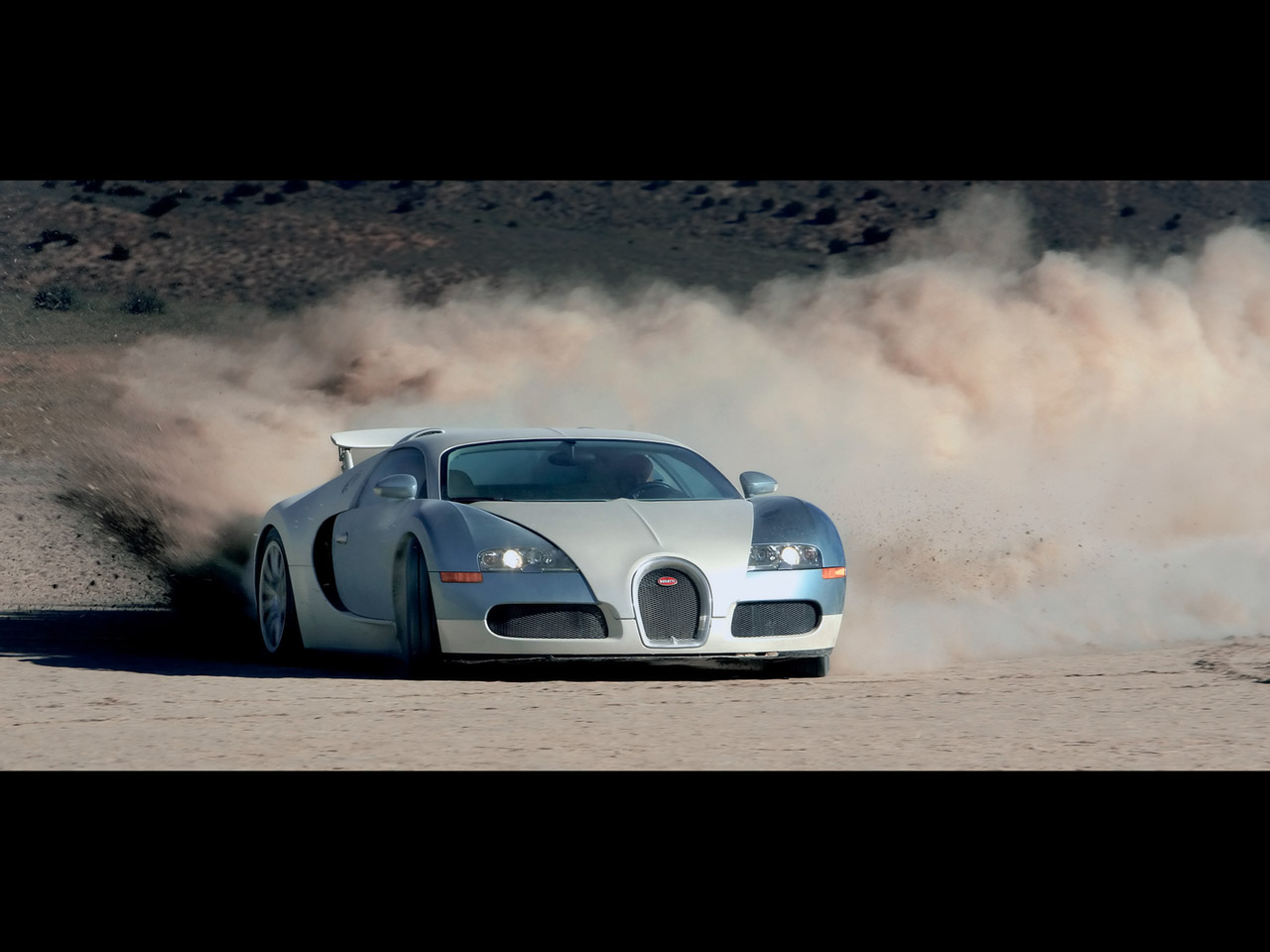Bugatti Definition
Source (google.com.pk)The Veyron features an 8.0-litre, quad-turbocharged, W16 cylinder engine, equivalent to two narrow-angle V8 engines. Each cylinder has four valves for a total of 64, but the narrow staggered V8 configuration allows two overhead camshafts to drive two banks of cylinders so only four camshafts are needed. The engine is fed by four turbochargers and displaces 7,993 cubic centimetres (487.8 cu in), with a square 86 by 86 mm (3.39 by 3.39 in) bore and stroke.
First U.S. Bugatti Veyron on display in April 2006
The transmission is a dual-clutch direct-shift gearbox computer-controlled automatic with seven gear ratios, with magnesium paddles behind the steering wheel and a shift time of less than 150 milliseconds, built by Ricardo of England rather than Borg-Warner, who designed the six speed DSG used in the mainstream Volkswagen Group marques. The Veyron can be driven in either semi-automatic or fully automatic mode. A replacement transmission for the Veyron costs just over US$120,000.[14] It also has permanent all-wheel drive using the Haldex Traction system. It uses special Michelin PAX run-flat tyres, designed specifically to accommodate the Veyron's top speed, and cost US$25,000 per set.[14] The tyres can be mounted on the rims only in France, a service which costs US$70,000.[14] Kerb weight is 1,888 kilograms (4,162 lb).[15] This gives the car a power-to-weight ratio, according to Volkswagen Group's figures, of 446.3 metric horsepower (328 kW; 440 bhp) per ton.
The car's wheelbase is 2,710 mm (106.7 in). Overall length is 4,462 mm (175.7 in) which gives 1,752.6 mm (69.0 in) of overhang. The width is 1,998 mm (78.7 in) and height 1,204 mm (47.4 in). The Bugatti Veyron has a total of ten radiators:[16]
3 heat exchangers for the air-to-liquid intercoolers.
3 engine radiators.
1 for the air conditioning system.
1 transmission oil radiator.
1 differential oil radiator.
1 engine oil radiator
It has a drag coefficient of 0.41 (normal condition) and 0.36 (after lowering to the ground),[17] and a frontal area of 2.07 m2 (22.3 sq ft).[18] This gives it a drag area – the combination of drag coefficient and frontal area, represented as CdA – of 0.74 m2 (8.0 sq ft).
[edit]Engine output
According to Volkswagen Group and certified by TÜV Süddeutschland, the final production Veyron engine produces 1,001 metric horsepower (736 kW; 987 bhp) of motive power, and generates 1,250 newton metres (922 lbf·ft) of torque.[1][19] The nominal figure has been stated by Bugatti officials to be conservative, with the real total being 1,020 metric horsepower (750 kW; 1,006 bhp) or more.
[edit]Top speed
German inspection officials recorded an average top speed of the original version of 408.47 km/h (253.81 mph)[6] during test sessions on the Ehra-Lessien test track on 19 April 2005.
The car's everyday top speed is listed at 350 km/h (220 mph). When the car reaches 220 km/h (140 mph), hydraulics lower the car until it has a ground clearance of about 9 cm (3.5 in). At the same time, the wing and spoiler deploy. In this handling mode the wing provides 3,425 newtons (770 lbf) of downforce, holding the car to the road.[16]
For top speed mode the driver must, while stationary, toggle a special top speed key to the left of the driver's seat. A checklist then establishes whether the car and its driver are ready to attempt to reach 407 km/h (253 mph). If so, the rear spoiler retracts, the front air diffusers shut, and normal 12.5 cm (4.9 in) ground clearance drops to 6.5 cm (2.6 in).
[edit]Braking
The Veyron's brakes use cross drilled, radially vented carbon fibre reinforced silicon carbide (C/SiC) composite discs, manufactured by SGL Carbon, which have a much greater resistance to brake fade when compared with conventional cast iron discs. The lightweight aluminium alloy monobloc brake calipers are made by AP Racing; the fronts have eight[16] titanium pistons and the rear calipers have six pistons. Bugatti claims maximum deceleration of 1.3 g's on road tyres. As an added safety feature, in the event of brake failure, an anti-lock braking system (ABS) has also been installed on the handbrake.
Prototypes have been subjected to repeated 1.0 g braking from 312 km/h (194 mph) to 80 km/h (50 mph) without fade. With the car's acceleration from 80 km/h (50 mph) to 312 km/h (194 mph), that test can be performed every 22 seconds. At speeds above 200 km/h (120 mph), the rear wing also acts as an airbrake, snapping to a 55° angle in 0.4 seconds once brakes are applied, providing an additional 0.68 g (6.66 m/s2) of deceleration (equivalent to the stopping power of an ordinary hatchback).[16] Bugatti claims the Veyron will brake from 400 km/h (250 mph) to a standstill in less than 10 seconds, though distance covered in this time will be half a kilometre (third of a mile).[16]
Bugatti Free Wallpaper Pics Pictures Hd for Desktop Iphone Mobile HD 1080p

Bugatti Free Wallpaper Pics Pictures Hd for Desktop Iphone Mobile HD 1080p

Bugatti Free Wallpaper Pics Pictures Hd for Desktop Iphone Mobile HD 1080p

Bugatti Free Wallpaper Pics Pictures Hd for Desktop Iphone Mobile HD 1080p

Bugatti Free Wallpaper Pics Pictures Hd for Desktop Iphone Mobile HD 1080p

Bugatti Free Wallpaper Pics Pictures Hd for Desktop Iphone Mobile HD 1080p

Bugatti Free Wallpaper Pics Pictures Hd for Desktop Iphone Mobile HD 1080p

Bugatti Free Wallpaper Pics Pictures Hd for Desktop Iphone Mobile HD 1080p

Bugatti Free Wallpaper Pics Pictures Hd for Desktop Iphone Mobile HD 1080p
%2C_5._April_2012%2C_D%25C3%25BCsseldorf.jpg%2F280px-Bugatti_Veyron_16.4_%25E2%2580%2593_Frontansicht_(1)%2C_5._April_2012%2C_D%25C3%25BCsseldorf.jpg)
Bugatti Free Wallpaper Pics Pictures Hd for Desktop Iphone Mobile HD 1080p

No comments:
Post a Comment